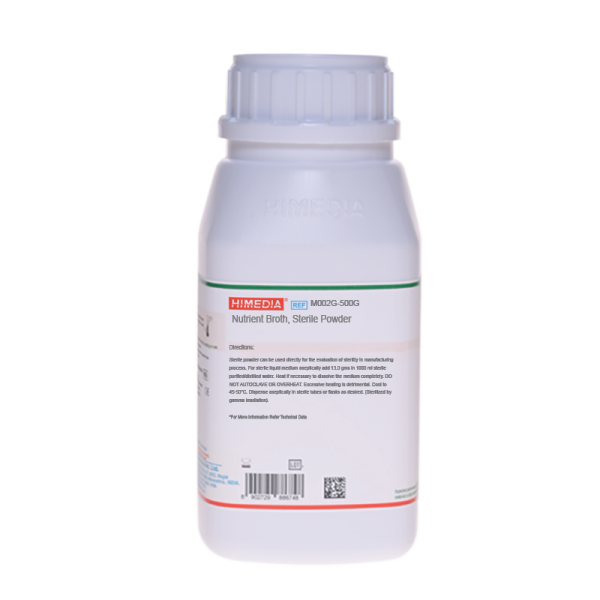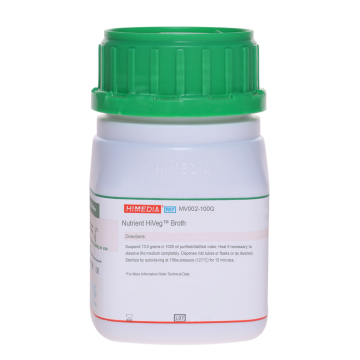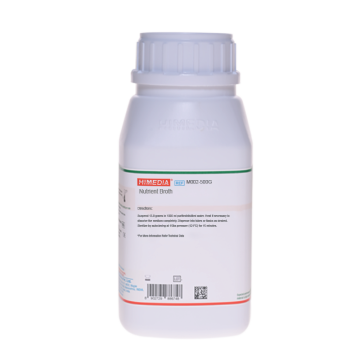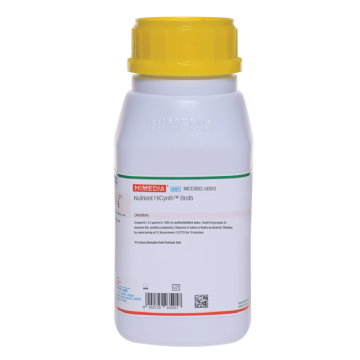 Your enquiry has been submitted
Your enquiry has been submitted
Nutrient Broth (γ-Irradiated)
Intended use
Sterile powder can be used for the general cultivation of less fastidious microorganisms
Composition**
| Ingredients | Gms/Litre |
|---|---|
| Peptone | 5.000 |
| Sodium chloride | 5.000 |
| HM peptone B# | 1.500 |
| Yeast extract | 1.500 |
Final pH (at 25°C): 7.4±0.2
**Formula adjusted, standardized to suit performance parameters
# - Equivalent to Beef extract
Directions
Sterile powder can be used directly for the evaluation of sterility in manufacturing process. For sterile liquid medium aseptically add 13.0 grams in 1000 ml sterile distilled / purified water. Heat if necessary to dissolve the medium completely. DO NOT AUTOCLAVE OR OVERHEAT. Excessive heating is detrimental. Dispense aseptically in sterile tubes or flasks as desired.
Principle And Interpretation
Nutrient media are basic culture media used for maintaining microorganisms, cultivating fastidious organisms by enriching with serum or blood and are also used for purity checking prior to biochemical or serological testing (5,6). Nutrient Broth has the formula originally designed for use in the Standard Method for Examination of Water and Waste water. It is one of the several non-selective media useful in routine cultivation of microorganisms (1, 7). It can be used for the cultivation and enumeration of bacteria which are not particularly fastidious. Addition of different biological fluids such as horse or sheep blood, serum, egg yolk etc. makes it suitable for the cultivation of related fastidious organisms.
Peptone, HM peptone B and yeast extract provide the necessary nitrogen compounds, carbon, vitamins and also some trace ingredients necessary for the growth of bacteria. Sodium chloride maintains the osmotic equilibrium of the medium.
Type of specimen
Food and dairy samples; Water samples
Specimen Collection and Handling
For food and dairy samples, follow appropriate techniques for sample collection and processing as per guidelines (1,7,8).
For water samples, follow appropriate techniques for sample collection, processing as per guidelines and local standards.(2)
After use, contaminated materials must be sterilized by autoclaving before discarding.
Warning and Precautions
Read the label before opening the container. Wear protective gloves/protective clothing/eye protection/ face protection. Follow good microbiological lab practices while handling specimens and culture. Standard precautions as per established guidelines should be followed while handling specimens. Safety guidelines may be referred in individual safety data sheets.
Limitations :
- This medium is general purpose medium and may not support the growth of fastidious organisms.
Performance and Evaluation
Performance of the medium is expected when used as per the direction on the label within the expiry period when stored at recommended temmperature.
Quality Control
Appearance: Cream to yellow homogeneous free flowing powder
Colour and Clarity of prepared medium: Light yellow coloured clear to slightly opalescent solution
Reaction: Reaction of 1.3% w/v aqueous solution at 25°C. pH : 7.4±0.2
pH: 7.20-7.60
Cultural Response
Cultural characteristics observed after an incubation at 35-37°C for 18-48 hours.
| Organism | Inoculum (CFU) | Growth |
|---|---|---|
| Escherichia coli ATCC 25922 (00013*) | 50-100 | good-luxuriant |
| Pseudomonas aeruginosa ATCC 27853 (00025*) | 50-100 | good-luxuriant |
| Salmonella Typhi ATCC 6539 | 50-100 | good-luxuriant |
| Staphylococcus aureus subsp.aureus ATCC 25923 (00034*) | 50-100 | good-luxuriant |
| Streptococcus pyogenes ATCC 19615 | 50-100 | good-luxuriant |
Key: *Corresponding WDCM numbers.
Storage and Shelf Life
Store between 10-30°C in a tightly closed container and the prepared medium at 15-25°C. Use before expiry date on the label. On opening, product should be properly stored dry, after tightly capping the bottle in order to prevent lump formation due to the hygroscopic nature of the product. Improper storage of the product may lead to lump formation. Store in dry ventilated area protected from extremes of temperature and sources of ignition Seal the container tightly after use. Use before expiry date on the label.
Product performance is best if used within stated expiry period.
Disposal
User must ensure safe disposal by autoclaving and/or incineration of used or unusable preparations of this product. Follow established laboratory procedures in disposing of infectious materials and material that comes into contact with sample must be decontaminated and disposed of in accordance with current laboratory techniques (3,4).
Reference
- American Public Health Association, Standard Methods for the Examination of Dairy Products, 1978, 14th Ed., Washington D.C.
- Baird R.B., Eaton A.D., and Rice E.W., (Eds.), 2015, Standard Methods for the Examination of Water and Wastewater, 23rd ed., APHA, Washington, D.C.
- Isenberg, H.D. Clinical Microbiology Procedures Handbook. 2nd Edition.
- Jorgensen, J.H., Pfaller, M.A., Carroll, K.C., Funke, G., Landry, M.L., Richter, S.S and Warnock., D.W. (2015) Manual of Clinical Microbiology, 11th Edition. Vol. 1.
- Lapage S., Shelton J. and Mitchell T., 1970, Methods in Microbiology', Norris J. and Ribbons D., (Eds.), Vol. 3A, Academic Press, London.
- MacFaddin J. F., 2000, Biochemical Tests for Identification of Medical Bacteria, 3rd Ed., Lippincott, Williams and Wilkins, Baltimore.
- Salfinger Y., and Tortorello M.L. Fifth (Ed.), 2015, Compendium of Methods for the Microbiological Examination of Foods, 5th Ed., American Public Health Association, Washington, D.C.
- Wehr H. M. and Frank J. H., 2004, Standard Methods for the Microbiological Examination of Dairy Products, 17th Ed.,APHA Inc., Washington, D.C.
Disclaimer:
User must ensure suitability of the product(s) in their application prior to use. Products conform solely to the information contained in this and other related HiMedia ™™ publications. The information contained in this publication is based on our research and development work and is to the best of our knowledge true and accurate. HiMedia™™ Laboratories Pvt Ltd reserves the right to make changes to specifications and information related to the products at any time. Products are not intended for human or animal or therapeutic use but for laboratory, diagnostic, research or further manufacturing use only, unless otherwise specified. Statements contained herein should not be considered as a warranty of any kind, expressed or implied, and no liability is accepted for infringement of any patents.
| Product Name | Nutrient Broth (γ-Irradiated) |
|---|---|
| SKU | M002G |
| Application/ Industry | General Purpose |
| Product Type | Regular |
| Physical Form | Powder |
| Origin | Animal |
| Packaging type | HDPE |
| References | 1. American Public Health Association, Standard Methods for the Examination of Dairy Products, 1978, 14th Ed., WashingtonD.C. 2.Salfinger Y., and Tortorello M.L. Fifth (Ed.), 2015, Compendium of Methods for the Microbiological Examination ofFoods, 5th Ed., American Public Health Association, Washington, D.C. 3.Baird R.B., Eaton A.D., and Rice E.W., (Eds.), 2015, Standard Methods for the Examination of Water and Wastewater,23rd ed., APHA, Washington, D.C. 4.Isenberg, H.D. Clinical Microbiology Procedures Handb0ook. 2nd Edition. 5.Jorgensen,J.H., Pfaller , M.A., Carroll, K.C., Funke, G., Landry, M.L., Richter, S.S and Warnock., D.W. (2015)Manual of Clinical Microbiology, 11th Edition. Vol. 1. 6.Lapage S., Shelton J. and Mitchell T., 1970, Methods in Microbiology, Norris J. and Ribbons D., (Eds.), Vol. 3A, AcademicPress, London. 7.MacFaddin J. F., 2000, Biochemical Tests for Identification of Medical Bacteria, 3rd Ed., Lippincott, Williams and Wilkins,Baltimore. 8.Wehr H. M. and Frank J. H., 2004, Standard Methods for the Microbiological Examination of Dairy Products, 17th Ed.,APHA Inc., Washington, D.C. |
| Customized Product Available | No |











